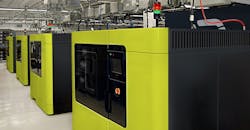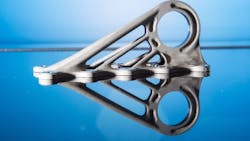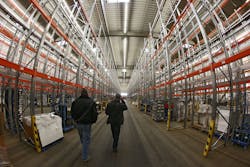We live in an on-demand society. Feel like a movie? Turn on Netflix and browse through thousands of movies your significant other doesn’t feel like watching. Hitting the clubs is more your thing? Order an Uber to have a stranger chauffeur you and your drunken friends around.
But what about when you get to work and have to find a prudent (cheap) and expedient way to produce 1,000 complex thingamabobs, but your regular Chinese supplier just jacked up the price because its workers Googled what a fair living wage is.
Luckily, manufacturing is now on-demand, too. By using 3D-Printing farms, a company can outsource the production of certain parts that can be more intricate, lighter, and cheaper. Those benefits have always increased the allure of additive manufacturing, though mostly in a “that-will-be-cool-when-it’s-feasible-for-me” way.
Now they are as 3D printing is branching out into the service market.
Think of these facilities as chicken coops that instead of eggs, are popping out whatever shape you want, in materials ranging from plastic to ceramic to metal. One such farm is Fast Radius (formerly CloudDDM) at UPS' Louisville, Ky., hub.
In May, SAP announced at its 28th annual Sapphire NOW conference that it’s partnering with UPS to help customers find the right “farm” for them, using its vast logistics network. It’s an end-to-end solution that will provide “repetitive and qualified and certified parts,” says Gil Perez, SVP of digital assets and IoT at SAP.
If you’re trying to make the best omelet, you probably won’t go to your shady neighbor that raises chickens in his backyard urban farm. You’ll go to a trusted grower who doesn’t use Lucky Charms crumbs as feed and actually cleans out the cages.
Same theory here with your product.
“If you want a manufacturer to put a label on it, they need to know the certification and regulatory requirements,” Perez explains.
This is especially vital in the aerospace industry, where regulations are tightest. It’s also a sector that can benefit the most from lighter parts, seeing as how the lighter something is, the less energy it takes to keep it in the air.
Last week, SAP announced a co-innovation agreement with Airbus subsidiary APWorks that should make the regular on-demand printing of aerospace parts a real option for manufacturers sooner rather than later. This will link supply chains to SAP’s HANA Cloud Platform and on-demand 3D printing manufacturing network and allow for printing components such as metal armrests and brackets.
It’s expected to reduce weight by up to one ton.
The first thing to be done is to digitize your inventory.
Perez says many large companies have vast catalogs of non-digitized parts, and they need to move from “paper to shape.”
After the SPL file is created, several other components need to be hashed out, including instructions, post-processing, handling, and even what type of 3D printer needs to be used.
“You need a very clear set of files that any 3D printing service can take and manufacture with reliability, according to specifications,” Perez explains.
Once everything is in the digital space, SAP can leverage its analytics to calculate how much can be saved by reducing physical inventory.
Maybe 3D printing will be more expensive upfront, but the overall cost of a good is more complicated. Warehousing and taxes could add up.
In 2015, the total inventory carrying costs in the U.S. was $427 billion, an increase of 5.1% from 2014, according to the CSCMP’s State of Logistics Report.
That breaks down into $141 billion for storage, $158 billion for financial cost, and $128 billion for “other,” which includes obsolescence, shrinkage, insurance, and more.
And the U.S Department of Commerce estimates overall inventory is at $1.8 trillion. With a sliver of change, just 1%, American manufacturers could cut inventory costs by $18 billion.
SAP says that multiple customers have reported that 30% - 50% of their aftermarket inventory parts are “sitting inventory,” meaning they have not been shipped or ordered in the last 12 months.
Manufacturers can find out what they could save using the SAP Product Lifecycle Costing solution to create predictive models to adjust alternative product structures, cost rates, and quantities. This could reduce design and development costs and speed time to market.
And with the highly regulated aerospace industry now boarding the on-demand movement, it signals how the current 3D printing market, projected to reach $15.7 billion by 2019, according to Wohlers Associates, can help other industries as well.
The big takeaway for Perez is that manufacturers can now include “3D native” parts into their designs.
“When you’re starting to think about 3D native parts, which have high computational capabilities, you can really do some amazing things,” he says.
About the Author
John Hitch
Editor, Fleet Maintenance
John Hitch, based out of Cleveland, Ohio, is the editor of Fleet Maintenance, a B2B magazine that addresses the service needs for all commercial vehicle makes and models (Classes 1-8), ranging from shop management strategies to the latest tools to enhance uptime.
He previously wrote about equipment and fleet operations and management for FleetOwner, and prior to that, manufacturing and advanced technology for IndustryWeek and New Equipment Digest. He is an award-winning journalist and former sonar technician aboard a nuclear-powered submarine where he served honorably aboard the fast-attack submarine USS Oklahoma City (SSN-723).



